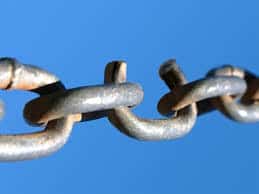… If you are a Designated Employer Representative (DER), training is key to a successful DOT drug & alcohol testing program, things that are your responsibility can go wrong. Learn the responsibilities of a DER. Online trainings are available.
Are Collection Sites the Weakest Link?
For some time, many people in the drug testing industry have held forth the conception that collection sites are the weak link in the drug testing process. While there is some truth in this assumption, it is not entirely true! There is an even weaker link in the entire drug testing process.
The collector has been blamed for many things from errors on the CCF to low specimen volume. The question has to be raised as to whether or not the collector is entirely to blame for all of these errors.
There are many responsible entities in the testing program from the collectors to the labs to the MROs and even the C/TPAs, DER’s and employers. All of these play a role in having a smooth running drug testing program. However, one very important component has been omitted in all of this.
This is the individual from which the drug test is being collected! What happened to concerns about the individual who is giving the actual specimen?
This individual is given a piece of paper or a CCF and is told to go to the collection facility. No instructions on what the expected procedure is are given from the supervisor or employment manager to the individual. The supervisor may not even know what the correct procedure is or even worse, care!
This individual reports to the collection facility as instructed. At the facility, this individual blindly follows the instructions of the collector. The donor has now put their trust in the collector who may or may not know what the correct procedure is. This collector may be trained and certified or may not be. How is the specimen donor to know the difference? Is the donor aware of this upcoming requirement?
Several things can occur which are a violation of a regulated drug test collection. These include:
· The donor is told to remove all clothing and does so. There is no physical exam taking place. Yet the donor does not know the difference and that is not a requirement.
· The donor is told to sign a medication form before even giving a specimen.
· The donor is told to sign the CCF certifying statement before even giving the specimen. They do not realize what the implications are or do not understand the statement.
· The donor is not instructed on what to expect upon entering the actual collection facility.
· The donor is told to place their specimen on the table and that they can go.
· They do not see the specimen being sealed in their presence.
· The collector does a specific gravity and pH before the specimen is sealed. Because one of the readings is low, the collector decides that another collection doing observed procedures is indicated.
· The donor is not given their copy of the form (Copy 5) or is given that copy and upon return to the company, told to turn it over to the Supervisor.
Do all of the above listed events happen? Yes, they do and probably more frequently than is realized by MROs, C/TPAs, DER’s, company representatives and federal regulatory authorites.
The donor is just doing what they have been told to do by the collector not knowing the difference between a good collection and a bad collection.
For the unaware, having a drug test collected can be a outrageous experience, especially when your job or career depends on it being collected correctly.
WHAT CAN BE DONE ABOUT THIS
All of the above mentioned events and more could be prevented by making the potential donor aware of what proper collection procedures are.
This can be easily achieved by having employee awareness classes that center around the collection process. With these classes, individuals can be informed of what is to be expected of them and what is to be expected of the collector. For example, I have developed such a training course titled “Your Urine, Your Career”. To groups to which I have presented to, the error rate from the collection sites drops. It is because the employees are aware of what the correct procedure and outcomes are.
Another training tool that could be equally effective is a handout or videotape that could be given to an individual who is about to undergo a drug test collection. Having an individual read a procedure handout or watch a videotape before having a specimen collection done will assist immensely in reducing collection site error or alleged collection site errors, especially when there is a positive drug test result.
The individual from whom the drug test is being collected is just as important as the other people. After all, it is they who are providing the actual specimen!







